Canada’s territories have the highest median after-tax income in the country, yet the region continues to see rising poverty and food insecurity rates, according to Statistics Canada.
Residents living in the territories—including the Northwest Territories, Nunavut, and Yukon—had a median after-tax income of $89,500 in 2022, yet the poverty rate came in at 24.2 percent, and 36.4 percent of households had some form of food insecurity, according to Statistics Canada figures.





